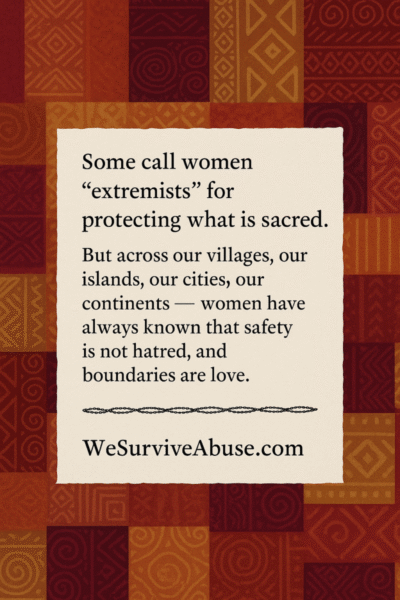Survivor advocacy has always required naming what endangers women and children — even when it’s unpopular.This isn’t the kind of work that earns a
Survivor advocacy has always required naming what endangers women and children — even when it’s unpopular.
This isn’t the kind of work that earns applause or bright lights.
In more than thirty years of doing it, the truths, the facts, and the stories I share have rarely been met with cheers or admiration.
But we keep going — because this work matters.
It is not glamorous, but it is sacred.
It is the steady heartbeat of those who refuse to let truth die in the dark.
We carry on, knowing that what we hold, what we speak, what we risk — saves lives, even when no one is clapping.
There’s nothing extreme about asking how policies affect women’s safety, children’s wellbeing, or the language we use to describe our bodies.
There’s nothing hateful about wanting clear boundaries in hospitals, shelters, locker rooms, or prisons.
But in this moment, even the simple act of questioning has been rebranded as extremism.
Why?
🔥 Because outrage pays better than understanding.
Social media rewards loudness, not logic.
So when a woman calmly says, “I believe biological sex matters in safeguarding,” her words are stripped of context and reposted as hate.
The nuance disappears, replaced by a headline that tells people what to feel before they’ve even heard the argument.
🧭 Because questioning power always provokes backlash.
Historically, women who refused to submit — to the church, to the state, to a man’s authority — were labeled dangerous.
Today, when women refuse to surrender truth to ideology, we get called “extremists.”
It’s the same old playbook with new language.
💔 Because true extremism hides behind moral performance.
Extremism isn’t found in women asking for privacy or accurate data.
It’s in systems that gaslight and silence dissent.
It’s in environments where people are punished for noticing patterns of harm.
Calling women “extremists” is a way of making them small again.
🌿 The heart of being gender-critical
Being gender-critical isn’t about division.
It’s about clarity.
It’s about saying: “We can love everyone while still protecting women’s boundaries.”
That’s not cruelty — that’s care.
It’s about holding the line so the next generation of girls won’t have to explain why their safety and dignity were negotiable.
It’s about saying that female-only spaces exist because violence against women exists — and that truth is neither hateful nor outdated.
“Clarity is not cruelty. Boundaries are not hate.
Women are not extremists for wanting to be safe.”
The conversation has been deliberately polarized.
Many activists and lobbyists frame any disagreement with gender ideology as hostility or bigotry. Instead of treating this as a legitimate policy debate — about prisons, sports, shelters, or language — it’s reframed as a moral battle of “good vs. evil.”
That’s propaganda logic, not truth-seeking.
Protecting women’s rights, child safeguarding, evidence-based healthcare — is not extreme. It’s rooted in ordinary ethics and longstanding human-rights principles.
There’s money and influence behind industries that profit from confusion — pharmaceuticals, political groups, and media brands that rely on “culture-war” clicks.
Labeling caution or safeguarding as “extremism” keeps people from asking follow-up questions.
If a position were truly indefensible, it wouldn’t need censorship to survive.
“Safety matters. Consent matters. Language matters. And women’s rights don’t disappear just because they’re inconvenient.”
That’s not extremism; that’s adulthood.
Affirmation:
I will not be shamed for valuing truth, safety, or biological reality. My boundaries are not bigotry — they are wisdom earned through generations of survival.
I will not be shamed for seeing what is real. I will not be silenced for defending the safety of women and children. Clarity is not cruelty. Truth is not extremism.